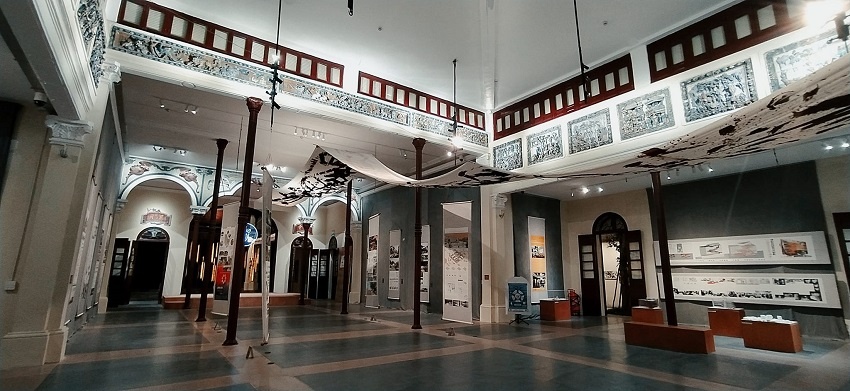Many interesting cultural activities will be held during the week of the Reunification Day (April 30) and May Day (May 1) in the Old Quarter area of Hanoi, according to Deputy Head of the Management Board of Hoan Kiem Lake and Hanoi Old Quarter Tran Thuy Lan.
| The exhibition space at the Arts and Culture Center, No 22 Hang Buom Street. Photo: Phuong Ngan |
This is an effort of the local authorities to foster tourism development and the vibrant image of Hanoi to international friends.
“Hanoi Old Quarter area, home to many craft streets with communal houses worshiping the trade ancestors, has been well preserved until nowadays. This is also the typical cultural trait of the capital city,” she said.
Local authorities always try to preserve and promote the value of these cultural heritages in order to attract more visitors to the capital, Lan said. “Regularly held cultural events in the Hanoi Old Quarter area often attract a large number of visitors since they are the highlights of Hanoi tourism,” she added.
A photo exhibition titled “Vietnamese traditional musicians and music” will open the week and will take place at Hanoi Old Quarter Culture Exchange Center, No 50 Dao Duy Tu Street.
The exhibition features 60 photos on the theme of Vietnamese music in the late 19th century. The collection was composed and digitally restored by architect Doan Bac and photographer Le Bich from various sources.
| The space of the installation “Dao Xa – preserving the soul of Vietnamese sound”. Photo: Dang cong san Newspaper |
The installation titled “Dao Xa – preserving the soul of Vietnamese sound” is underway at Kim Ngan Communal House, No 42-44 Hang Bac Street.
Located some 60 kilometers away from Hanoi’s center, Dao Xa Village in Ung Hoa District, Hanoi is famous for the trade of making musical instruments that have been passed down from generation to generation. The artisans are now striving to preserve their ancestors’ legacy.
Dao Xuan Lan is the ancestor who introduced the trade of making musical instruments to the villagers in the late 18th and early 19th centuries. He was later employed by a Frenchman in Hanoi and achieved fame in the capital city. Then, Dao Xuan Ai, the oldest son of Dao Xuan Lan took up the profession and established a music instrument store named Trung Hoa at 51 Hang Ga Street in Hanoi. Trung Hoa used to be a famous trademark for traditional hand-made musical instruments in Asia.
The Ho Guom Information and Culture Center, No 2 Le Thai To Street holds an art exhibition-themed propaganda painting to celebrate the 47th anniversary of the Reunification Day, May Day, and the 132nd birthday of President Ho Chi Minh.
| The poster “Nothing is more precious than independence and freedom”. Photo: Rednet |
The art of propaganda paintings used to be a powerful spiritual weapon, effectively serving political tasks and mobilizing the masses for the revolution (1945 – 1975).
The highlights of the exhibition include the paintings “Spring 1975 – Celebrating the Liberation of the Central Highlands” by Le Thiep; “Hooray for the liberation of Hue” by Nguyen Tien Canh; and “April 30, 1975: Complete victory for Vietnam” by Pham Lung, among others.
In addition, the Ho Guom Information and Culture Center also introduces the installation about the period of the centrally planned economy.
According to local economic researchers, the period in Vietnam began in 1954 in the North and in 1975 nationwide. It ended in 1986 with the introduction of market reforms known as Doi moi or Renovation. During this period, food, goods, and services were purchased with coupons or food stamps. The artifacts and images related to this period are arranged in a vivid way, which will give viewers the most authentic look at a difficult time.
| The exhibition-themed craft of rattan knitting from Vinh Ba Village, Phu Yen Province is organised at Quan De Temple, No 28 Hang Buom Street. Photo: Dan Viet |
The exhibition “22 Hang Buom Memory” and “Memories of To River” takes place at the Arts and Culture Center, No 22 Hang Buom Street.
A street resembles an ever-flowing river, where generations come and go. In that endless passage of time, each street is filled with joy and sorrow. Hang Buom Street is a prime example of a street lying next to a river. It was known for trading sails and boat-related equipment.
Today, the brown sails only exist in distant memory, just like the countless changes and people who went and leave. No 22 Hang Buom, like a water vortex, sweeping in every up and down of this street’s history. There exist stories of people, of the street, of the old days, of today, of Europe and Asia, of the ancient capital people, and of Hanoians today.
Stepping into the exhibition space of 22 Hang Buom Memory, visitors may get to witness the wonder of time and its layers. The artists have been collecting and connecting fragments of history, to let them illuminate with a beauty that seems spontaneous yet full of meaning, simple yet incredibly profound.
The craft of rattan knitting from Vinh Ba Village, Phu Yen Province is on display at Quan De Temple, No 28 Hang Buom Street. The village is also an attractive heritage tourist destination in Phu Yen province.
Last but not least, a photo exhibition titled “Vietnam – A strip of love” is held at the sidewalk area of Hoan Kiem Lake walking space (opposite the temple of King Le) by the Hanoi-based 3G Plus group, including photographer Pham Tien Dung, Nguyen Thanh Ha, Vu Hai, Nguyen Tan Tuan, Doan Bac and Le Bich.
| Visitors to the photo exhibition titled “Vietnam – A strip of love”. Photo: Dan Viet |









